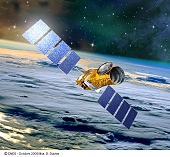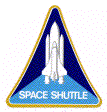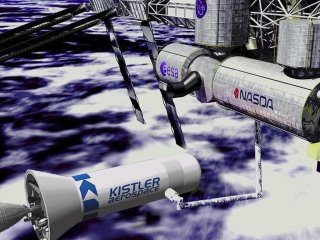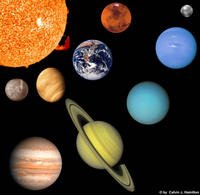 The French and European Space Agency have plans to launch the COROT spacecraft in December to look for exoplanets, or planets outside of our solor system. NASA is not far behind, planning to send the Kepler into space in October 2008. And how many explanets have been discovered to date? According to the California and Carnegie Planet Search site, about 182 exoplanets have been detected by astronomers. For example, the site currently highlights a "Super-Earth" orbiting the star Gliese 876. This newly discovered planet is a 7.5 Earth-mass planet orbiting this star and the lowest mass exoplanet known to be nearby.
The French and European Space Agency have plans to launch the COROT spacecraft in December to look for exoplanets, or planets outside of our solor system. NASA is not far behind, planning to send the Kepler into space in October 2008. And how many explanets have been discovered to date? According to the California and Carnegie Planet Search site, about 182 exoplanets have been detected by astronomers. For example, the site currently highlights a "Super-Earth" orbiting the star Gliese 876. This newly discovered planet is a 7.5 Earth-mass planet orbiting this star and the lowest mass exoplanet known to be nearby.
Monday, November 27
The Search for New Planets
 The French and European Space Agency have plans to launch the COROT spacecraft in December to look for exoplanets, or planets outside of our solor system. NASA is not far behind, planning to send the Kepler into space in October 2008. And how many explanets have been discovered to date? According to the California and Carnegie Planet Search site, about 182 exoplanets have been detected by astronomers. For example, the site currently highlights a "Super-Earth" orbiting the star Gliese 876. This newly discovered planet is a 7.5 Earth-mass planet orbiting this star and the lowest mass exoplanet known to be nearby.
The French and European Space Agency have plans to launch the COROT spacecraft in December to look for exoplanets, or planets outside of our solor system. NASA is not far behind, planning to send the Kepler into space in October 2008. And how many explanets have been discovered to date? According to the California and Carnegie Planet Search site, about 182 exoplanets have been detected by astronomers. For example, the site currently highlights a "Super-Earth" orbiting the star Gliese 876. This newly discovered planet is a 7.5 Earth-mass planet orbiting this star and the lowest mass exoplanet known to be nearby.
All is Quiet with the God of War
 The Mars Global Surveyor went quiet on November 2nd, and the chance of restoring communications is slim. The spacecraft has been circling Mars for more than 10 year, about 8 years longer than anticipated, so we have been lucky to date. Mars is still covered by a variety of craft, including the Mars Reconnaissance Orbiter, Mars Odyssey, two Mars rovers, and Mars Express. The problem is believed to be a disabled solar power array. For more on the mission, visit this link.
The Mars Global Surveyor went quiet on November 2nd, and the chance of restoring communications is slim. The spacecraft has been circling Mars for more than 10 year, about 8 years longer than anticipated, so we have been lucky to date. Mars is still covered by a variety of craft, including the Mars Reconnaissance Orbiter, Mars Odyssey, two Mars rovers, and Mars Express. The problem is believed to be a disabled solar power array. For more on the mission, visit this link.
Monday, September 4
First Alberto, and Now Ernesto!
 Fortunately, the Atlantis crew is back in Florida getting ready for their delayed flight. After Ernesto was downgraded to a tropical storm, everything was back on track. Which is important since the International Space Station is already behind schedule and a total of 15 flights will be necessary to finalize the project. Let's hope nothing scuttles the Wednesday launch. Hey, maybe it is time to consider some alternative launch sites. The predicted weather for Florida is not all that sunny in the years to come. The Sunshine State has become the Sometime State. Just as we are diversifying away from the old shuttle, let's think about diversifying away from the old Cape Canaveral. Back up systems are a good thing.
Fortunately, the Atlantis crew is back in Florida getting ready for their delayed flight. After Ernesto was downgraded to a tropical storm, everything was back on track. Which is important since the International Space Station is already behind schedule and a total of 15 flights will be necessary to finalize the project. Let's hope nothing scuttles the Wednesday launch. Hey, maybe it is time to consider some alternative launch sites. The predicted weather for Florida is not all that sunny in the years to come. The Sunshine State has become the Sometime State. Just as we are diversifying away from the old shuttle, let's think about diversifying away from the old Cape Canaveral. Back up systems are a good thing.Update: The Atlantis did not actually get off the ground until September 9, but the overall mission was a success. The shuttle still sustained some damage, but this time from space debris. NASA noted "The hit, which left a hole about one-tenth of an inch in diameter, didn't endanger the spacecraft or the crew, nor did it affect mission operations." For more NASA shuttle news go here.
Sunday, August 20
The Great Space Race
 NASA deserves credit for motivating and financially backing private sector initiatives to travel into space. The space agency started a competition for a privately-run workhorse (called COTS for "Commercial Orbital Transportation Services") to assist NASA with future space lifts to the International Space Station (and who knows, maybe the Moon and beyond). NASA's concern is that the Shuttles will go offline in 2010 and the planned Crew Exploration Vehicle may not be available until 2014. The commercial spacecraft could will the gap and meet other future needs as well.
NASA deserves credit for motivating and financially backing private sector initiatives to travel into space. The space agency started a competition for a privately-run workhorse (called COTS for "Commercial Orbital Transportation Services") to assist NASA with future space lifts to the International Space Station (and who knows, maybe the Moon and beyond). NASA's concern is that the Shuttles will go offline in 2010 and the planned Crew Exploration Vehicle may not be available until 2014. The commercial spacecraft could will the gap and meet other future needs as well.So NASA offered the winner(s) of the contest $500 million in seed money, something it has never attempted before. About two dozens companies competed and NASA announced the two winners last Friday - SpaceX and Rocketplane Kistler.
"By stimulating the development of commercial orbital spaceflight, the NASA COTS program will have the same positive effect on space travel as the Air Mail Act of 1925 had on the development of safe and affordable air transportation," said Elon Musk, SpaceX CEO. "Moreover, the requirement for significant private investment and the fact that NASA only pays for objective, demonstrated milestones ensures that the American taxpayer will receive exceptional value for money."
The new support for the space industry could lead to additional spinoffs, including space tourism. Stay tuned.
For more on the contest, click here.
For more on the overall NASA initiative, click here.
Update: A $3.9 billion dollar contract was awarded to Lockheed Martin Corp. to build the Crew Exploration Vehicle. The multi-part contract is expected to cost as much as $7.5 billion through 2019. For more visit this link.
Saturday, August 19
Alone in Space - And Almost Blind!
 Hubble still hovers over our planet, but its camera stopped working back in June possibly due to a bad transistor. The telescope/spacecraft was launched back in 1990 and has been the subject of prior rescue efforts. Fortunately, NASA was able to work around the problem and get the camera back online.
Hubble still hovers over our planet, but its camera stopped working back in June possibly due to a bad transistor. The telescope/spacecraft was launched back in 1990 and has been the subject of prior rescue efforts. Fortunately, NASA was able to work around the problem and get the camera back online. "This is the best possible news," said Ed Ruitberg, deputy associate director for the Astrophysics Division at NASA's Goddard Space Flight Center, Greenbelt, Md. "We were confident we could work through the camera issue, and now we can get back to doing more incredible science with the camera." (Click here for more on the story.)
In addition to a bad transistor, NASA noted that the Hubble needs new batteries and gyroscopes to remain operational beyond next year. With the Shuttle delays and International Space Station backlog, it will be interesting if NASA can find the time and funds to make the necessary repairs. We have been well served by Hubble, including the fantastic picture of Jupiter above, and it would be nice if we could keep it going for many more years.
Update: NASA has decided to send a rescue mission to save the Hubble. The overall mission is slated for May 2008 and is expected to cost $900 million and last 11 days. With the repairs, the Hubble should remain active until at least 2013. Visit this link for more information.
Ever Hear of 2004 XP14?
 No, this is not a new reusable rocket designed by Boeing. It is the name of an asteroid that missed the earth by 269,000 miles last month - appoximately the distance between the Earth and the Moon. The half-mile wide asteroid was first spotted back in 2004 (hence its name). If you missed it this time don't you worry. It will be back another 10 times over the next century (the rest being near misses as well, or so we hope).
No, this is not a new reusable rocket designed by Boeing. It is the name of an asteroid that missed the earth by 269,000 miles last month - appoximately the distance between the Earth and the Moon. The half-mile wide asteroid was first spotted back in 2004 (hence its name). If you missed it this time don't you worry. It will be back another 10 times over the next century (the rest being near misses as well, or so we hope).
Wednesday, August 2
But Will We Want to Come Back?
Have you heard of the Alliance to Rescue Civilization (with the cute acronym ARC)? While it may sound a little wild to worry about the day we can no longer live on this lovely blue planet, maybe they have the right idea. Always know where the fire exit is before you settle down in a new place.
ARC's mission is to "protect the human species and its civilization from destruction that could result from a global catastrophic event, including nuclear war, acts of terrorism, plague and asteroid collisions." How about simply bad management? None of that here, right?
The group envisions an off-site location, such as a space station or the moon, to act as a back up system. The site would store seeds, DNA, historic records, technology, literature, and more. Could we maybe store a leader or two up there - don't worry, we will call you if we need you.
We have already left a lot of our memories and technology around the solar system, and some is even leaving the solar system on the Voyager spacecraft. And what about the Russian and American space junk on the moon?
So why not try to be more orderly about it? I support the idea of a backup system, but let's also make sure we take care of what we have. The problem with any backup system is that we may take the original for granted. We may not be able to do a lot about an asteroid (though some would disagree), but war, terrorism and plague is a human specialty that we could do without (and should try and remove from the body politic, not move it out into space).
ARC's mission is to "protect the human species and its civilization from destruction that could result from a global catastrophic event, including nuclear war, acts of terrorism, plague and asteroid collisions." How about simply bad management? None of that here, right?
The group envisions an off-site location, such as a space station or the moon, to act as a back up system. The site would store seeds, DNA, historic records, technology, literature, and more. Could we maybe store a leader or two up there - don't worry, we will call you if we need you.
We have already left a lot of our memories and technology around the solar system, and some is even leaving the solar system on the Voyager spacecraft. And what about the Russian and American space junk on the moon?
So why not try to be more orderly about it? I support the idea of a backup system, but let's also make sure we take care of what we have. The problem with any backup system is that we may take the original for granted. We may not be able to do a lot about an asteroid (though some would disagree), but war, terrorism and plague is a human specialty that we could do without (and should try and remove from the body politic, not move it out into space).
Tuesday, July 4
Discovery is Off!
 Great news...the delays are over and Discovery is off the ground. Neither weather nor foam would get the better of the shuttle. It is not necessarily encouraging that NASA spent millions of dollars to reengineering the insulation on the external tank and still the safefy inspector voted against the launch. According to NASA Administrator Michael Griffinm "You could mail 10 of these things with the cost of a single first-class stamp. We're talking about a very, very minor piece of foam here. This is not an issue." Are you reassured? For updates on the mission click here.
Great news...the delays are over and Discovery is off the ground. Neither weather nor foam would get the better of the shuttle. It is not necessarily encouraging that NASA spent millions of dollars to reengineering the insulation on the external tank and still the safefy inspector voted against the launch. According to NASA Administrator Michael Griffinm "You could mail 10 of these things with the cost of a single first-class stamp. We're talking about a very, very minor piece of foam here. This is not an issue." Are you reassured? For updates on the mission click here.
Friday, June 16
Yes, I Admit It...
 Okay, let's just get it on the table. Space facts are fascinating, but so are space stories, real or otherwise. Under unreal comes science fiction, but let's not dismiss it too quickly. How many astronomers were first stimulated by watching Star Trek? Check out this page to learn more on this issue. Of course, we should leave room for skeptics. Nonetheless, I must admit I am enjoying the drama on Battlestar Galactica. Is it because of the hard science? No. In fact, the entire show is more like a Norse drama - "We will all die in the end, but drink up and prepare for another battle!" Still, we sometimes need the animation of possibility to become interested again in reality. Astronomers may seem like a dry lot, but they can be dreamers as well. In fact, I would not trust any group if it did not have space for dreamers. So let's keep our eyes open and our hopes high.
Okay, let's just get it on the table. Space facts are fascinating, but so are space stories, real or otherwise. Under unreal comes science fiction, but let's not dismiss it too quickly. How many astronomers were first stimulated by watching Star Trek? Check out this page to learn more on this issue. Of course, we should leave room for skeptics. Nonetheless, I must admit I am enjoying the drama on Battlestar Galactica. Is it because of the hard science? No. In fact, the entire show is more like a Norse drama - "We will all die in the end, but drink up and prepare for another battle!" Still, we sometimes need the animation of possibility to become interested again in reality. Astronomers may seem like a dry lot, but they can be dreamers as well. In fact, I would not trust any group if it did not have space for dreamers. So let's keep our eyes open and our hopes high.
Monday, June 12
Mars Society is Meeting
The Mars Society has announced its 9th Annual International Mars Society Conference. The conference runs from August 3rd through the 6th. Speakers include Michael Griffin, NASA's Administrator. This is a way for enthusiasts to show their support for the Red Planet.
Thanks, Alberto
 It is nice to see the shuttle being readied again. Unfortunately, the events may be delayed as tropical storm Alberto runs across the state. Space Shuttle Discovery is expected to launch on July 1 and stay up for about 12 days as the crew conducts repairs on the International Space Station. It is important that we get the shuttle back on track. However, as mentioned earlier on this page, we also need to be thinking post-shuttle. What is next?
It is nice to see the shuttle being readied again. Unfortunately, the events may be delayed as tropical storm Alberto runs across the state. Space Shuttle Discovery is expected to launch on July 1 and stay up for about 12 days as the crew conducts repairs on the International Space Station. It is important that we get the shuttle back on track. However, as mentioned earlier on this page, we also need to be thinking post-shuttle. What is next?
Friday, March 24
What is Japan Up To?
 The Japan Aerospace Exploration Agency is in the process of retrieving asteroid samples. The Hayabusa spacecraft , launched in May 2003, intercepted the asteroid Itokawa, landed on its surface, collected approximately 1/10 of an ounce of material, and is now on the way back to Earth. Of course, that's the theory. JAXA is now wondering whether it actually obtained a sample, and also whether or not the craft will ever make it make to Earth. A fuel leak has jeopardized its timely return - originally set for June 1007. It is more likely to return in June 2010, if JAXA is lucky. The good news is that the spacecraft also carried a series of names to the asteroids surface - 877,490 to be exact - including the name Arthur C. Clark. Let's keep our fingers crossed for a safe return.
The Japan Aerospace Exploration Agency is in the process of retrieving asteroid samples. The Hayabusa spacecraft , launched in May 2003, intercepted the asteroid Itokawa, landed on its surface, collected approximately 1/10 of an ounce of material, and is now on the way back to Earth. Of course, that's the theory. JAXA is now wondering whether it actually obtained a sample, and also whether or not the craft will ever make it make to Earth. A fuel leak has jeopardized its timely return - originally set for June 1007. It is more likely to return in June 2010, if JAXA is lucky. The good news is that the spacecraft also carried a series of names to the asteroids surface - 877,490 to be exact - including the name Arthur C. Clark. Let's keep our fingers crossed for a safe return.Note: JAXA also has other things underway, including building components of the International Space Station, space planes, and a mission to Venus.
Thursday, March 23
More on Mars...
 Now that the Mars Reconnaissance Orbiter is in orbit around the Red Planet (after a 7 month journey) we may learn more about our neighbor. The MRO will circle the planet for the next four years, collecting enough data to keep scientists busy for years to come. In addition to looking for water, the MRO will look at potential landing sites for future robotic, and possible human, explorers. The MRO is also one of many craft now circling Mars - the Mars Global Surveyor (NASA), Mars Odyssey (NASA) and Mars Express (ESA) are also scanning the planet's surface. In addition, NASA still has two rovers on the surface poking around. Things are getting crowded.
Now that the Mars Reconnaissance Orbiter is in orbit around the Red Planet (after a 7 month journey) we may learn more about our neighbor. The MRO will circle the planet for the next four years, collecting enough data to keep scientists busy for years to come. In addition to looking for water, the MRO will look at potential landing sites for future robotic, and possible human, explorers. The MRO is also one of many craft now circling Mars - the Mars Global Surveyor (NASA), Mars Odyssey (NASA) and Mars Express (ESA) are also scanning the planet's surface. In addition, NASA still has two rovers on the surface poking around. Things are getting crowded.
Sunday, March 12
What 's Next with Atlantis on its Way Out?
 With NASA announcing the retirement of the Atlantis shuttle by 2008, one wonders where our space program is going next. Sadly, we are down to three shuttles, and now Atlantis will be cannibalized for parts. Of course, Atlantis has been in use for more than 20 years, but I have not seen a lot of press on the replacements. The President spoke of traveling to Mars, and yet we cannot even maintain the rickety crafts that transports people and materiel to local satellites and the space station. Maybe we need to get the private companies into the act even sooner. This is not a new idea - read this USAToday editorial by Robert Zimmerman, an award-winning space historian.
With NASA announcing the retirement of the Atlantis shuttle by 2008, one wonders where our space program is going next. Sadly, we are down to three shuttles, and now Atlantis will be cannibalized for parts. Of course, Atlantis has been in use for more than 20 years, but I have not seen a lot of press on the replacements. The President spoke of traveling to Mars, and yet we cannot even maintain the rickety crafts that transports people and materiel to local satellites and the space station. Maybe we need to get the private companies into the act even sooner. This is not a new idea - read this USAToday editorial by Robert Zimmerman, an award-winning space historian.
Saturn or Bust
 It seems that NASA's Cassini spacecraft, a cooperative project of NASA, the European Space Agency and the Italian Space Agency, may have found evidence of liquid water reservoirs on Saturn's moon Enceladus. The water erupts from the moon's surface in large geysers. We know of other moons with water, including Jupiter's Europa with its internal seas, and even our Moon with water reserves deep down near its poles. However, it is still an interesting set of circumstances since we know that water is essential to life as we know it. Maybe we are not such oddballs after all. Click here for more.
It seems that NASA's Cassini spacecraft, a cooperative project of NASA, the European Space Agency and the Italian Space Agency, may have found evidence of liquid water reservoirs on Saturn's moon Enceladus. The water erupts from the moon's surface in large geysers. We know of other moons with water, including Jupiter's Europa with its internal seas, and even our Moon with water reserves deep down near its poles. However, it is still an interesting set of circumstances since we know that water is essential to life as we know it. Maybe we are not such oddballs after all. Click here for more.
Wednesday, February 15
VSS Enterprise
 Space Adventures is not the only player in town. Virgin Galactic also offers space enthusiasts the opportunity to travel to the Earth's outer reaches. Richard Branson, Paul G. Allen and Burt Rutan have teamed up to create a new class of traveler who wants to "hurtle through the edges of the atmosphere" and "see the cobalt blue sky turn to mauve and indigo and finally black...Out will come the stars, clear and bright... even though it is daytime!" And what is the power source? Nitrous oxide (laughing gas) and rubber, which Virgin Galactic claims is much safer than liquid propulsion systems or solid fuel rockets. And it seems folks are interested. Morethan $10 million has been collected from future passengers, and the waiting list includes William Shatner and Stephen Hawkings. The plan is to procure five spacecraft and send more than 700 people into space the first 18 months. Again, new ideas for the future. Let's give NASA and others a run for their money.
Space Adventures is not the only player in town. Virgin Galactic also offers space enthusiasts the opportunity to travel to the Earth's outer reaches. Richard Branson, Paul G. Allen and Burt Rutan have teamed up to create a new class of traveler who wants to "hurtle through the edges of the atmosphere" and "see the cobalt blue sky turn to mauve and indigo and finally black...Out will come the stars, clear and bright... even though it is daytime!" And what is the power source? Nitrous oxide (laughing gas) and rubber, which Virgin Galactic claims is much safer than liquid propulsion systems or solid fuel rockets. And it seems folks are interested. Morethan $10 million has been collected from future passengers, and the waiting list includes William Shatner and Stephen Hawkings. The plan is to procure five spacecraft and send more than 700 people into space the first 18 months. Again, new ideas for the future. Let's give NASA and others a run for their money.
Tuesday, February 7
So You Want to Go Into Orbit?
 While the traditional route to space orbit has been a long training program at NASA, the private sector is now opening up new opportunties. For example, Space Adventures has programs from low orbit in a Mig-25, a trip to the International Space Station, and even travel around the moon. Space Adventures sells itself as "the only company in the world currently operating commercial orbital spaceflight and will be the first to launch clients using a new breed of lower cost suborbital spacecraft currently under development worldwide." Let's hope this new breed of space travel continues to grow. While government programs have done all of the work to date (or through others on contract basis), it may be time to try new approaches. And why stop with the Earth. We need a race to Mars, and these low cost private options may be the way to do it.
While the traditional route to space orbit has been a long training program at NASA, the private sector is now opening up new opportunties. For example, Space Adventures has programs from low orbit in a Mig-25, a trip to the International Space Station, and even travel around the moon. Space Adventures sells itself as "the only company in the world currently operating commercial orbital spaceflight and will be the first to launch clients using a new breed of lower cost suborbital spacecraft currently under development worldwide." Let's hope this new breed of space travel continues to grow. While government programs have done all of the work to date (or through others on contract basis), it may be time to try new approaches. And why stop with the Earth. We need a race to Mars, and these low cost private options may be the way to do it.
Wednesday, January 25
The Little "Snowstorm" That Couldn't
 Remember the famous Buran (Russian for "Snowstorm") shuttle designed by the USSR to compete with NASA's shuttle? In fact, it looked almost identical from a distance. What ever happened to this experimental craft? When looking up some of the details I found that the Buran came off the production line in 1984, test launched in 1988, and was moth-balled in 1993. Last word is that the manufacturing plant now makes diapers and a Buran 1:1 scale version became a restaurant in Gorky Park. The Russians have a lot to be proud of throughout the space race, but this was not its high moment. Click here for more on the current Russian programs, including the OBSTANOVKA space weather project related to the International Space Station.
Remember the famous Buran (Russian for "Snowstorm") shuttle designed by the USSR to compete with NASA's shuttle? In fact, it looked almost identical from a distance. What ever happened to this experimental craft? When looking up some of the details I found that the Buran came off the production line in 1984, test launched in 1988, and was moth-balled in 1993. Last word is that the manufacturing plant now makes diapers and a Buran 1:1 scale version became a restaurant in Gorky Park. The Russians have a lot to be proud of throughout the space race, but this was not its high moment. Click here for more on the current Russian programs, including the OBSTANOVKA space weather project related to the International Space Station.Tuesday, January 24
What is the Kuiper Belt?
The Kuiper Belt is the region beyond Neptune containing much of the same material used to form our solar system. Pluto is one of the larger bodies from this area, but it is also the home of the comets that frequent the inner solar system. The Kuiper Belt was proposed by Dutch astronomer Jan Oort back in 1950. However it is astronomer Gerard Kuiper who has his name associated with this belt. His predictions concerning comets from this region were not fully proven until 1992. So all of this is still recent science. And what about Pluto? It is the monster of ice planets? Actually, no. In fact, Xena holds this title. Read here for more.
Sunday, January 22
2.9 Billion Miles - For Dust?
 NASA's Stardust space capsule is now safely back on Earth after quite a journey. Scientists are now studying the payload (about one teaspoon of dust) that successfully landed in the Utah desert. We will now learn much more about the comets that circle our solar system and thereby more about the early foundations of our own planet some 4.5 billion years ago. Visit NASA's Jet Propulsion Laboratory for more on the progress of the research.
NASA's Stardust space capsule is now safely back on Earth after quite a journey. Scientists are now studying the payload (about one teaspoon of dust) that successfully landed in the Utah desert. We will now learn much more about the comets that circle our solar system and thereby more about the early foundations of our own planet some 4.5 billion years ago. Visit NASA's Jet Propulsion Laboratory for more on the progress of the research.
Friday, January 20
Viewing New Horizons
 We are off to a great start as we head towards the last planet in the solar system! The 3 billion mile trip to Pluto began yesterday and now we have a show that will last at least 9.5 years. NASA's New Horizons spacecraft broke away from Earth's and will someday visit Pluto and then break away from the inner solar system and inspect the Kuiper Belt - a cold and ice filled region from which planetoids periodically appear. You can monitor this little craft by visiting the Johns Hopkins University site.
We are off to a great start as we head towards the last planet in the solar system! The 3 billion mile trip to Pluto began yesterday and now we have a show that will last at least 9.5 years. NASA's New Horizons spacecraft broke away from Earth's and will someday visit Pluto and then break away from the inner solar system and inspect the Kuiper Belt - a cold and ice filled region from which planetoids periodically appear. You can monitor this little craft by visiting the Johns Hopkins University site.Note: This if the first entry of Mars or Bust...a site designed to keep you wondering about this amazing world. Be it Pluto, Mars, the Milky Way or the Big Bang itself, the investigation is just beginning.
Labels:
Johns Hopkins University,
Kuiper Belt,
NASA,
New Horizons,
Pluto
Subscribe to:
Comments (Atom)
